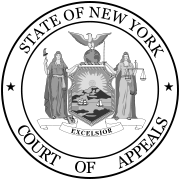
Tedla v. Ellman
Encyclopedia

New York Court of Appeals
The New York Court of Appeals is the highest court in the U.S. state of New York. The Court of Appeals consists of seven judges: the Chief Judge and six associate judges who are appointed by the Governor to 14-year terms...
case that was influential in establishing the bounds of the negligence per se
Negligence per se
Negligence per se is the legal doctrine whereby an act is considered negligent because it violates a statute . In order to prove negligence per se, the plaintiff must show that# the defendant violated the statute,...
doctrine. Ordinarily, a statutory violation constitutes negligence
Negligence
Negligence is a failure to exercise the care that a reasonably prudent person would exercise in like circumstances. The area of tort law known as negligence involves harm caused by carelessness, not intentional harm.According to Jay M...
. However, the court, in an opinion written by Irving Lehman
Irving Lehman
Irving Lehman was an American lawyer and politician from New York. He was Chief Judge of the New York Court of Appeals from 1940 until his death in 1945.- Biography:...
, instead held that because this violation occurred in a situation not anticipated by the drafters of the statute and was in keeping with the spirit of the statute, it did not constitute negligence.
Facts
Anna Tedla and her brother, John Bachek (plaintiffs), were struck by a passing automobile, operated by the defendant, Ellman. Anna was injured and Bachek was killed. Bachek was a deaf-mute. The plaintiff had engaged in collecting and selling junk. They picked up junk at the incinerator of the village of Islip, New York. At the time of the accident, plaintiffs were walking along and wheeling baby carriages containing junk and wood. It was about six o'clock on a Sunday evening in December. Bachek was carrying a lighted lantern. The jury found that the accident was due solely to the negligence of the operator of the automobile. The place of the accident consisted of two roadways, separated by a grass plot. There were no footpaths along the highway and the center grass plot was soft. It is not unlawful for a pedestrian, wheeling a baby carriage, to use the roadway under such circumstances. The Vehicle and Traffic Law (Cons. Laws, ch. 71) provided that "Pedestrians walking or remaining on the paved portion, or traveled part of a roadway shall be subject to, and comply with, the rules governing vehicles, with respect to meeting and turning out, except that such pedestrians shall keep to the left of the center line thereof, and turn to their left instead of right side thereof, so as to permit all vehicles passing them in either direction to pass on their right. Such pedestrians shall not be subject to the rules governing vehicles as to giving signals." The plaintiffs did not and were not observing the statutory rule. At the time of the accident, they were proceeding in easterly direction on the east-bound or right-hand roadway.Procedural history
The defendant moved to dismiss the complaint on the ground, among others, that violation of the statutory rule constitutes contributory negligenceContributory negligence
Contributory negligence in common-law jurisdictions is defense to a claim based on negligence, an action in tort. It applies to cases where a plaintiff/claimant has, through his own negligence, contributed to the harm he suffered...
as a matter of law. The trial judge left to the jury the question whether failure to observe the statutory rule was a proximate cause
Proximate cause
In the law, a proximate cause is an event sufficiently related to a legally recognizable injury to be held the cause of that injury. There are two types of causation in the law, cause-in-fact and proximate cause. Cause-in-fact is determined by the "but-for" test: but for the action, the result...
of the accident. The trial judge found for P, which the appellate division affirmed. On this appeal, D argues the pedestrians were contributorily negligent as a matter of law for violating the statute.
Ellman appealed an order from the Appellate Division affirming a judgment entered upon a verdict in favor of Tedla in their action for negligence.

